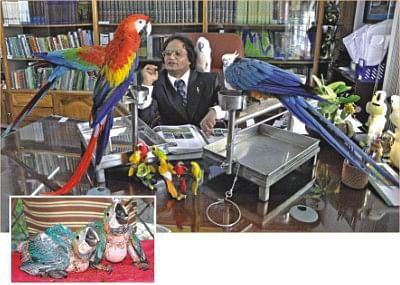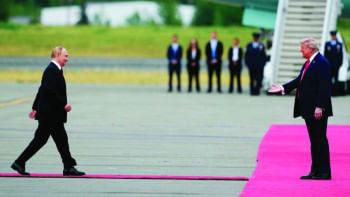<i>Macaws breed in captivity</i>

Abdul Wadud, owner of a private mini zoo, with his collection of exotic birds at his house in the capital. Inset: Two blue-and-gold macaw chicks hatched out recently in his zoo on CR Dutta Road in Dhaka. Photo: Courtesy
Two blue-and-gold macaw eggs hatched in a private zoo in Dhaka, the first time macaws bred in captivity in Bangladesh.
The two chicks are healthy and growing. They are monitored round the clock via close-circuit cameras and are shown to visitors on a large screen at the zoo.
Abdul Wadud, the owner of the private mini zoo at 22/2 Bir Bikram CR Dutta Road, bought a pair of the birds in 1997 from Brazil.
Since then he has been researching and experimenting on how to breed the birds in captivity.
The climate and environment of the sub-continent is not ideal for macaw breeding, especially in captivity. This year, however, the female macaw laid eggs in a metal box containing cedar shavings and woodchips in April, June and again in August. The first four eggs were not fertile while the third batch of two eggs hatched.
The highly intelligent and magnificently colourful Brazilian species originally come from deep in the Amazon rainforest and are cherished as pets and familiar worldwide as showpiece birds.
The blue-and-gold macaw, also known as the blue-and-yellow macaw, is one of the largest and grandest of all parrots. The pattern of dark lines on the face of these parrots is unique to each individual bird. They are about 35 inches (90cm) in length from head to tail. They have an average lifespan of 50 years.
The practice of macaws being kept in captivity has continued since the 18th century. The first breeding of these birds occurred in 1818 in Magdeburg Zoo of Germany.
Most blue-and-gold macaws live in pairs or in family groups in the wild. Macaw pairs may join other macaws to form flocks. This happens especially during feeding, roosting and during migratory trips.
Even after reaching maturity, macaws stay with their parents for up to a year and start breeding after another two to three years.
Abdul Wadud also has a large collection of exotic foreign birds. The scarlet macaw, hahns macaw, Bourke's parakeet, rainbow lory, sun conure, African grey parrot, rock pebbler western rosella, port lincoln, electus parrot, kakariki, eastern rosella, chattering lory and black-capped-lory are some of the species in his collection.

 For all latest news, follow The Daily Star's Google News channel.
For all latest news, follow The Daily Star's Google News channel. 



Comments